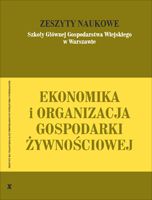Main Article Content
Article Details
BÖHM-BAWERK E. von, 1889: Kapital und Kapitalzins, Wagnersche Universitats-Buch-handlung, Innsbruck.
BRÓDKA D.S., CHCIAŁOWSKI M., 2017: Price Volatility in Macroeconomic Structure of Production in Poland, Acta Scientiarum Polonorum. Oeconomia 16(3), 5–13.
GARRISON R.W., 1978: Austrian Macroeconomics: A Diagrammatical Exposition, Andrews and McMeel, Kansas City.
GARRISON R.W., 2002: Time and Money, Taylor & Francis Group, London and New York.
HAGEDORN H., 2017: A Theory of Interest Rates, pobrano z: https://www.luebeck.de/file-admin/media/AustrianEconomics2017/pdf/a_theory_of_interest_rates-positive_theory.pdf [dostęp: 03.11.2019].
HAHN L.A., 1956: Common Sense Economics, Abelard-Schumann Limited, Norwich.
HAYEK F.A. von, 2010: The Counter-Revolution of Science: Studies on the Abuse of Reason, Liberty Fund, Springville.
HOPPE H.H., 2007: Economic Science and the Austrian Method, Ludwig von Mises Institute, Auburn.
HUERTA de SOTO J., 2006: Spór metodologiczny (Methodenstreit) Szkoły Austriackiej, pobrano z: http://mises.pl/pliki/upload/methodenstreit.pdf [dostęp: 30.10.2019].
HUERTA de SOTO J., 2008: The Austrian School: Market Order and Entrepreneurial Creativity, Edward Elgar Publishing Limited, Cheltenham.
HÜLSMANN J.G., 1997: Knowledge, Judgment, and the Use of Property, Review of Austrian Economics 10(1), 23–48.
HÜLSMANN J.G., 2011: The structure of production reconsidered, pobrano z: http://granem.univ-angers.fr/_resources/Cahiers/2011/DT_GRANEM_034.pdf [dostęp: 07.11.2019].
JĘDRUCHNIEWICZ A., 2013: Struktura cen w polskim cyklu gospodarczym. Faza wzrostu, Bank i Kredyt 44(1), 99–118.
JĘDRUCHNIEWICZ A., 2015: Struktura cen w polskim cyklu gospodarczym. Faza spadku, Ekonomia. Rynek, Gospodarka, Społeczeństwo 40, 59–83.
KIRZNER I.M., 1963: Market Theory and the Price System, D. van Nostrand, Princeton.
KIRZNER I.M., 1982: Competition, Regulation, and the Market Process: An “Austrian” Perspective,pobrano z: https://www.cato.org/sites/cato.org/files/pubs/pdf/pa018.pdf [dostęp: 30.10.2019].
KIRZNER I.M., 1997: Entrepreneurial Discovery and the Competetive Market Process: An Austrian Approach, Journal of Economic Literature 10(1), 60–85.
KIRZNER I.M., 2011: The Pure Time-Preference Theory of Interest: An Attempt at Clarification, [w:] J.M. Herbener (red.), The Pure Time-Preference Theory of Interest, Ludwig von Mises Institute, Auburn.
LACHMANN L.M., 1978: Capital and Its Structure, Andrews and McMeel, Kansas City.
LU D., 2011: Fundamentals of Supply Chain Management, pobrano z: http://library.ku.ac.ke/wp-content/downloads/2011/08/Bookboon/Magement%20andOrganisation/fundamentals-of-supply-chain-management.pdf [dostęp: 08.11.2019].
MENGER C., 2007: Principles of Economics, Ludwig von Mises Institute, Auburn.
MISES L. von, 1998: Human Action a Treatise on Economics, Ludwig von Mises Institute, Auburn.
MISES L. von, 2006: The Causes of Economic Crisis, [w:] L. von Mises (red.), The Causes of Economic Cises and Other Essays Before and After The Great Depression, Ludwig von Mises Institute, Auburn.
ROTHBARD M.N., 2009: Man, Economy and State. A Treatise on Economic Principles with Power and Market,Ludwig von Mises Institute, Auburn.
SHIBATA K., 1935: On Bohm-Bawerk’s Theory of Interes-Rate, Kyoto University Economic Review 10(1), 107–127.
SIMPSON B.D., KJAR S.A., 2005: Circular Flow, Austrian Price Theory and Social Appraisement, Quarterly Journal of Austrian Economics 8(4), 3–13.
SKOUSEN M., 2011: Struktura produkcji. Giełda, kapitał, konsumpcja,Fijor Publishing, Warszawa.
SKOUSEN M., 2012: Narodziny współczesnej ekonomii. Żywoty i idee wielkich myślicieli, Fijor Publishing, Warszawa.
SKOUSEN M., 2015: Logika ekonomii,Fijor Publishing, Warszawa.
STRIGL R. von, 2000: Capital & Production, Ludwig von Mises Institute, Auburn.
ZVIRBULE-BERZINA A., 2011: The role of enterprise integration in agriculture entrepreneurship. Proceedings of 8th International Conference "Economic Integration, Competition and Cooperation", 6-9 April, Opatija, University of Rijeka – Faculty of Economics. https://doi.org/10.2139/ssrn.2232640
Downloads
- Andrzej Buszko, Regionalne zróżnicowanie szarej strefy w Polsce – potencjalny wpływ na rozwój , Zeszyty Naukowe SGGW - Ekonomika i Organizacja Gospodarki Żywnościowej: Nr 125 (2019)
Możesz również Rozpocznij zaawansowane wyszukiwanie podobieństw dla tego artykułu.
- Andrzej Jędruchniewicz, Popytowe przyczyny inflacji w Polsce , Zeszyty Naukowe SGGW - Ekonomika i Organizacja Gospodarki Żywnościowej: Nr 72 (2008)
- Andrzej Jędruchniewicz, Jacek Maśniak, Przemiany własnościowe ziemi rolnej w Polsce , Zeszyty Naukowe SGGW - Ekonomika i Organizacja Gospodarki Żywnościowej: Nr 121 (2018)
- Andrzej Jędruchniewicz, Wybrane metody analizy zależności kosztów od wielkości produkcji , Zeszyty Naukowe SGGW - Ekonomika i Organizacja Gospodarki Żywnościowej: Nr 36 (1999)
- Andrzej Jędruchniewicz, Nakłady inwestycyjne w przemyśle spożywczym , Zeszyty Naukowe SGGW - Ekonomika i Organizacja Gospodarki Żywnościowej: Nr 50 (2003)






 Profil w Bazie Wiedzy
Profil w Bazie Wiedzy